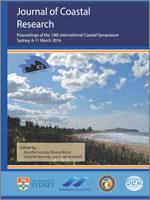Choi, T.J.; Park, J.Y., and Choi, J.Y., 2016. Partitioning of Grain-size Component Populations in Bimodal Sediments, Proceedings of the 14th International Coastal Symposium (Sydney, Australia). Journal of Coastal Research, Special Issue, No. 75, pp. 1322 - 1326. Coconut Creek (Florida), ISSN 0749-0208.
Most continental shelf sediments show bi- and/or poly-modal patterns consisting of overlapping components in the grain-size distribution (GSD), which generally reflect various environmental conditions as well as multiple sources of sediment. Because the laser-diffraction method is accurate and requires only a few grams, it is useful for analyzing cores with complex sedimentary structures of alternating coarse and fine lamina. In this study mathematical method of the partitioning of component (PCP) is applied to high-resolution GSD analysis for a sediment core collected from the central Yellow Sea (14YS-PC-3, 261 cm). Coarser and finer components within the GSDs of the core sediments with a typical bi-modal pattern were separated by PCP method, and then the textural parameters of each component were recalculated. The upper part (0–75 cm) of the core consists of homogenous muddy sediments of about 8.31 Φ in mean grain size, while bi-modal muddy sands with 6–7 Φ in Mz are predominant at the lower part. Mz of the coarse components are about 4.13 Φ and remain constant throughout the core. The fine components are, however, in a range of 5.52 Φ to 8.71 Φ in Mz showing a typical fining-upward trend, and the amounts of fine component tend to increase upward. This result indicates that the fine component is a main factor determining Mz in the lower part (deeper than 75 cm). The trends of GSD by PCP might be related to the status of depositional energy level during the transgression stage of the Holocene period. Consequently, application of PCP to precise GSD data, together with the geochemical, palaeontological and age-dating data, can contribute to the better understanding of sediment sources and comprehensive paleo-environmental conditions.





